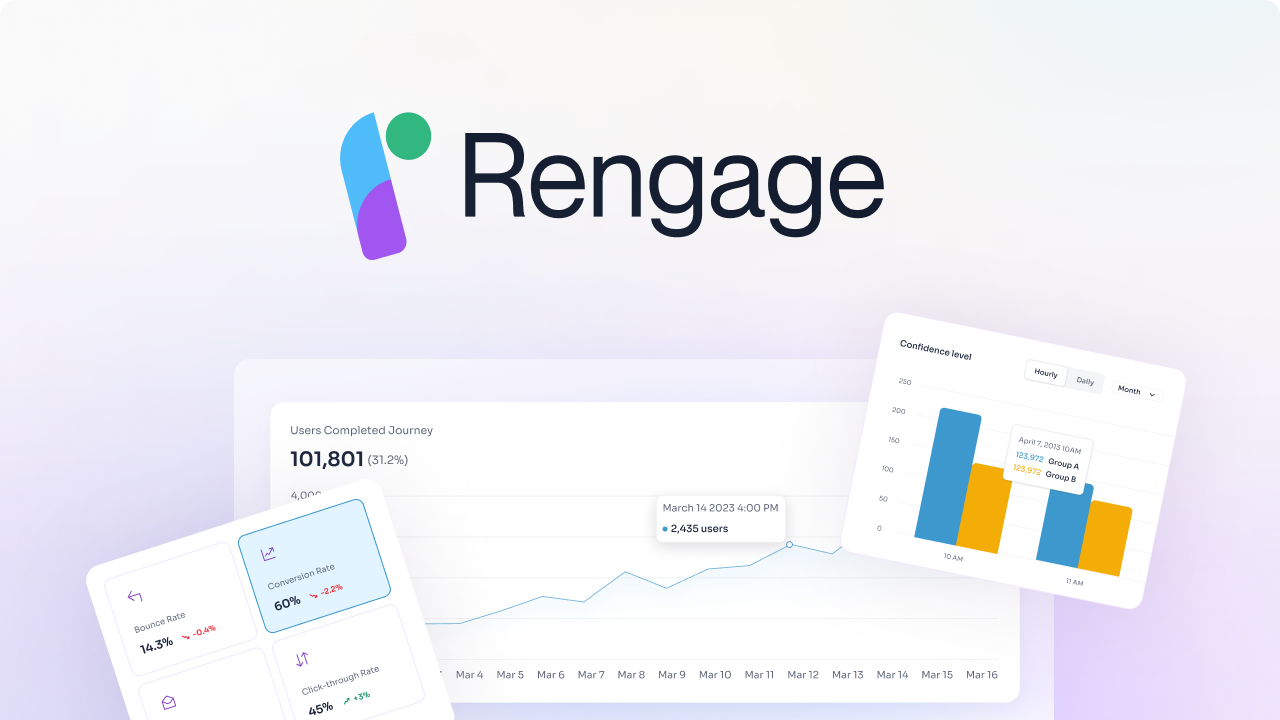Understanding customer journey stages is crucial for businesses looking to optimize their customer lifecycle management. By breaking down the journey into stages, you can identify pain points, improve customer experience, and ultimately boost retention rates. This blog post will take you through the various stages of the customer journey and provide actionable tips for each stage, ensuring you're maximizing customer satisfaction at every touchpoint.
What is the Customer Journey?

The customer journey is a crucial concept in modern marketing. It refers to the series of steps a customer takes from the first interaction with a brand to the eventual loyalty that is built over time. For a business, understanding the customer journey entails knowing the various ways in which customers interact with a brand and optimizing these experiences at every touchpoint.
A successful business strategy can be created, primarily by focusing on the customer journey. By mastering the customer journey, you can design customer experiences that lead to better customer relationships, loyalty, and long-term retention.
Customer Journey vs. the Buyer Journey
It is vital to understand that the stages of the customer journey are distinct from those of the buyer journey. The buyer's journey follows the customer experience from initial brand awareness to the purchase of a product. The customer journey, however, extends beyond the purchase and examines how customers interact with your product and share their experiences with others.
Related Reading
8 Benefits of Understanding the Customer Journey Stages

1. Understand customer behavior
Understanding customer behavior is crucial for businesses in various industries because it helps them figure out why customers do what they do. By classifying every action customers take, businesses can better position themselves to support their needs.
2. Identify touchpoints to reach the customer
Businesses invest in multichannel marketing, but not all of these touchpoints are valuable. By focusing on the customer journey, businesses can learn which channels are the most effective for generating sales, saving time and money by focusing on the most effective channels.
3. Analyze the stumbling blocks in products or services
If leads frequently bail before buying, that could be a sign that something is wrong with your product or buying experience. Being conscious of the customer journey can help businesses fix issues with products or services before they become a more expensive problem.
4. Support your marketing efforts
Marketing requires a deep familiarity with the target audience. Documenting the customer journey makes it easier for the marketing team to meet shoppers’ expectations and solve their pain points.
5. Increase customer engagement
Seeing the customer journey helps businesses target the most relevant audience for their product or service, improves the customer experience, and increases engagement. Increasing positive customer touchpoints has never been more important.
6. Achieve more conversions
Mapping the customers’ journey can help businesses increase conversions by tailoring and personalizing their approach and messages to give the audience exactly what they want.
7. Generate more ROI
Tangible return on marketing efforts is essential. Investing in the customer journey improves ROI across the board. For example, brands with a good customer experience can increase revenue by 2–7%.
8. Improve customer satisfaction and loyalty
Today, 94% of customers say a positive experience motivates them to make future purchases. Optimizing the customer journey helps businesses meet shopper expectations, increasing satisfaction and loyalty.
What Are the 5 Essential Customer Journey Stages?

Awareness Stage
The awareness stage is a potential customer’s first impression of your brand, so it is worth a significant investment. They may encounter your brand passively by viewing an online or in-person advertisement. Or, they may have actively discovered your brand while researching a problem using a search engine.
Brand Awareness Strategies
You should aim to educate prospective customers about your brand and offerings through ads, social media accounts, your website, and other high-level touchpoints (also known as “top of the funnel” touchpoints).
Targeting Potential Customers
This customer journey stage aims to meet the right customers at the right time. It’s all about getting your brand name in front of your ideal customers, even if they don’t know they need your service.
Consideration Stage
In this stage, a potential customer is now aware of your brand and is researching whether your company or product is what they need. This customer journey stage aims to move the customer to further engage with your brand and closer to a purchase or decision.
During the consideration phase, you must ensure your offering stands out among the competition. A customer in the consideration phase may spend time on your website, review your social media pages, engaging with your sales team, and seek out what others say about your brand. This can include Google, G2, Capterra, Yelp, or Facebook reviews. They may also ask experienced friends, colleagues, or family members for recommendations.
First Purchase/Decision Stage
By now, the customer has gathered all the information they need about your brand — such as case studies or online reviews — and is ready to purchase. At this stage, they decide between your brand or product and your competition. This phase is significant because it demonstrates that the customer has confidence in your brand and may lead to a purchase or sale.
The main players during this stage are the customer and your sales team. Your customer service or implementation teams may also be involved if the purchase includes an integration or installation process.
Retention/Loyalty Stage
The overarching goal of this phase is to keep your customers happy so they become loyal, lifelong customers.
59% of U.S. customers say that once they’ve found a brand they love, they are loyal for life. Just because a customer has made an initial purchase with your company doesn’t mean your work is finished. Your team still has opportunities to educate the customer on the value of your brand, paving the way for additional purchases, upsells, or contract renewals.
Advocacy Stage
The advocacy stage aims to enable your most loyal customers to recommend and advocate for your brand.
Customers can become vocal supporters of your brand when they have positive and meaningful experiences with your products or services. This support can drive significant results for your organization, with 81% of U.S. and U.K. customers stating that they trust product recommendations from family and friends over brand messaging.
Related Reading
- Digital Customer Journey Mapping
- Customer Journey Analysis
- Ecommerce Customer Journey
- B2B Customer Journey
- Customer Journey Orchestration
- Omnichannel Customer Journey
- Saas Customer Journey
- Marketing Automation Customer Journey
- Customer Journey Optimization
- Micro Moments Customer Journey
- Customer Journey Research
- Customer Journey Automation
- Customer Journey Insights
- Customer Journey Dashboard
- Customer Journey Personalization
- Customer Journey Metrics
- Customer Journey Best Practices
How Can You Improve Each Customer Journey Stage?

Customer journey mapping is a crucial exercise that businesses must undertake to understand how customers interact with their brand. It involves plotting various journeys that customers might take, using a mix of data and intuition to identify touchpoints along the way. By creating multiple maps, businesses can uncover weak areas in the journey that need optimization. This exercise helps businesses understand the entire customer experience and make improvements where necessary.
Listen like you mean it
Listening to customer feedback is a fundamental aspect of building better customer journeys. By collecting feedback from every stage of the journey, businesses can gain insights into customer experiences, identify pain points, and make necessary improvements. Employing the right technology, such as customer surveys, conversational analytics, and AI solutions, can help in automatically generating insights from customer data. Listening ensures that businesses are aware of issues and can address them promptly.
Get Personal
Treating each customer journey as unique is essential for delivering personalized experiences. By using tools like Qualtrics Experience iD, businesses can create individual customer profiles and identify issues through AI and past interactions.
This personalization approach helps turn each customer into an advocate and allows businesses to identify common experience gaps. By focusing on individual customer journeys, businesses can improve satisfaction levels and foster customer loyalty on a large scale.
23 Best Tools for Managing the Customer Journey Stages

1. Rengage
Rengage offers a comprehensive solution for customer journey management. It accelerates customer journeys from onboarding to conversion and churn. With features like Journey Moments and Journey Builder, Rengage provides insights into micro-segments, intuitive multi-channel marketing automation, and insights prediction and attribution.
2. UXPressia
UXPressia is a cloud-based platform for customer experience management. It enables teams to visualize, share, and improve customer journeys. Along with customer journey mapping, UXPressia offers tools for creating Customer/Buyer Personas and Impact Maps.
3. Lucidchart
Lucidchart is a visual tool for capturing the customer experience. It helps target specific personas, increase customer engagement, and boost revenue. With customizable templates and formatting options, Lucidchart simplifies the process of customer journey mapping.
4. Microsoft Visio
Microsoft Visio is a software for creating various diagrams, including customer data diagrams. It provides built-in shapes, objects, and stencils for easy diagramming and simplifying the process of customer journey mapping.
5. Gliffy
Gliffy is a web-based editor and visualization tool for creating and editing diagrams. It offers features like Venn diagrams and organizational charts.
6. Custellence
Custellence is an intuitive customer journey mapping tool that allows users to create and share customer journey maps easily. It offers a low learning curve and features like flexible map structure, curve lanes for customer emotions, and unique image collection.
7. OmniGraffle
OmniGraffle is a diagramming and customer journey mapping tool for creating precise and neat customer journey maps. With a free trial available, it is easy to get started with OmniGraffle.
8. Smaply
Smaply is a visual customer experience management software for creating journey maps, personas, and stakeholder maps. It enables users to visualize journey maps with different details like storyboards, channels, and live data for KPIs.
9. IBM Journey Designer
IBM Journey Designer allows users to produce customer journey maps quickly and collaboratively. It features a user-friendly, drag-and-drop interface for visualizing cross-channel journeys and designing tailored customer experiences.
10. Visual Paradigm
Visual Paradigm’s suite helps streamline UX initiatives and automate the information acquisition process. It offers tools for customer journey mapping and agile project management, including PM Process Tool and Agile Process Tool.
11. InMoment
InMoment is a platform for transforming feedback data into actionable customer insights. It provides visualizations of customer touchpoints and interactions, enhancing the understanding of the customer journey.
12. SuiteCX
SuiteCX is an easy-to-update tool that combines diagnostics, storytelling, prioritization, and planning for customer experience management. It offers various Customer Journey Mapping visualization templates and tools with interaction and segment information stored in a centralized database.
13. cx/omni CEM cloud
CX/Omni CEM cloud is a customer experience management platform that includes a customer journey mapping tool. It helps monitor customer sentiment, pain points, emotional journeys, and performance gaps.
14. Qualtrics
Qualtrics is an Experience Management software with solutions for customer experience and employee experience. After acquiring Clarabridge, Qualtrics enhanced its Voice of the customer feedback tool with AI-powered listening insights.
15. Miro
Miro is a collaboration tool for creating customer journey maps, wireframes, roadmaps, and more. It centralizes communication for cross-functional teamwork and offers a toolkit for customer journey mapping.
16. Trello
Trello is a visual collaboration tool for planning tasks and projects. It simplifies customer journey mapping, making it easier for teams to organize, prioritize, and create detailed maps.
17. Asana
Asana is a project and task management app that facilitates team communication and collaboration. It allows users to create and track customer journey maps collaboratively from start to finish.
18. Mapovate
Mapovate is a customer journey mapping solution with real-time voice of customer analytics. It supports drawing and visualizing customer journeys, creating personas, defining journeys for customer profiles, and collaborating with team members.
19. FigJam
FigJam is a whiteboard tool for brainstorming, ideation, and mapping customer journeys. Developed by Figma, it offers a collaborative and interactive platform for working on customer journey maps.
20. Totango
Totango is a customer success platform for managing customer experience and mapping customer journeys. It helps track product usage and adoption, measure success initiatives, and analyze buying and usage patterns.
21. Canvanizer
Canvanizer is a canvas software with basic business plan templates for various uses. It includes features like a timer, templates, export options, history logs, and shared access for collaborative work.
22. Reveall
Reveall is a product discovery platform for mapping customer journeys. It offers features like centralizing data, analyzing findings, prioritizing product roadmap, integrating multiple data sources, and transcribing customer interviews.
23. Woopra
Woopra is a software for journey analytics reporting and web analytics, providing insights into customer journeys and user behavior.
Related Reading
- Customer Lifecycle Management Software
- Customer Journey Mapping Tools
- Customer Journey Management
- Braze Alternative
- Fullstory Alternatives
- Adobe Analytics Alternatives
- Customer Journey Analytics Tools
- Iterable Competitors
- Marketo Alternatives
- Onesignal Alternatives
- Clevertap Alternatives
- Bloomreach Alternatives
- Customer.io Alternatives
Create Personalized Experiences That Drive Loyalty and Growth with Rengage — Book A Free Demo Today
Rengage provides a complete solution for managing and enhancing customer journeys, offering insights and measurable outcomes without the need for coding. We accelerate customer journeys from onboarding and activation to conversion and churn, enabling customers to unlock revenue from their existing user base.
With Rengage, you can gain insights into your segments, run campaigns using an intuitive journey manager, and measure how your journeys impact user conversion through our Journey Moments and Journey Builder features.
Journey Moments
Journey Moments in Rengage provide insights into micro-segments of your user base. This feature enables you to understand how different user segments interact with your product or service, helping you tailor your marketing efforts to address their specific needs. By gaining insights into these micro-segments, you can create personalized and targeted marketing campaigns that are more likely to resonate with your users.
Journey Builder
The Journey Builder feature in Rengage offers an intuitive multi-channel marketing automation tool. With Journey Builder, you can create and execute marketing campaigns across various channels, such as email, SMS, and in-app messages. This tool simplifies the process of running multi-channel campaigns, ensuring that your marketing efforts are coordinated and consistent across all touchpoints.
Insights Prediction and Attribution
Rengage provides insights into how your customer journeys impact user conversion. By using predictive analytics and attribution modeling, you can understand which touchpoints are most effective in driving user engagement and conversion. This information allows you to optimize your marketing efforts, focusing on the channels and strategies that yield the best results for your business.
Transforming Customer Interactions
By leveraging the features of Rengage, you can transform customer interactions into personalized experiences that drive loyalty and growth. By understanding your user segments, running targeted campaigns, and measuring the impact of your efforts, you can create a seamless customer journey that enhances user engagement and drives conversions.
Book a free demo to learn more about how Rengage can help you unlock revenue and drive growth through personalized customer experiences.
